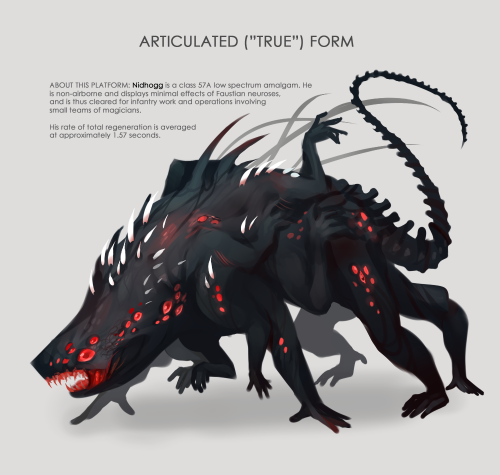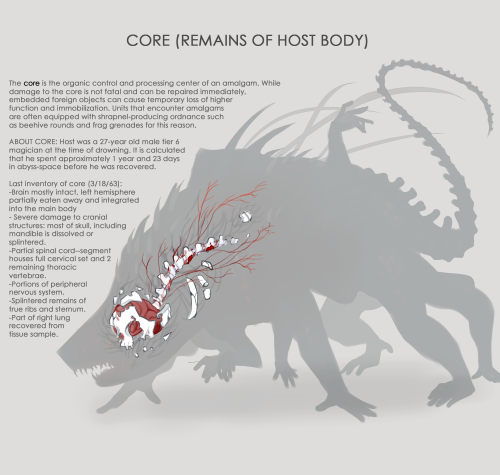#man i worked really hard on this
ayyyyyy come look at my fucked up OC
Amalgams are mobile platforms that consist of stacked colonies of microscopic entities informally known as demons, which are bonded parasitically to the body of a magician. A byproduct of magic use on or near significant quantities of standing water, demons spontaneously swarm puddles or lakes in the presence of magical energy. They crave and feed on magic, which also appears to have a cohesive effect on them: normally individualistic, single-cell-like demons will bond together while feeding and create larger and more intuitive beings.While demons largely ignore normal humans (although ingestion of contaminated water may result in severe health problems), they will aggressively pursue magicians, who often avoid and fear water for this reason. Demons are highly parasitic in nature, and contact with bare skin will result in them burrowing into and anchoring themselves to the body of the magic user, where they will remain, feeding off their latent energy. While smaller sites of contamination on the limbs can be localized and easily removed, the same cannot be said for the unfortunate magician who falls into a teeming lake of demons.The event is called a ‘drowning’ among magician lingo, and the effect is said to be similar to throwing a magnet into a pile of iron filings. The demons will maul the unlucky mage, stripping them layer-by-layer of skin, organs, and bone until only a ragged approximation remains. This becomes the magical core of an amalgam–brought together around it, the demons will collectively form a new body and begin behaving like a single, sentient organism.While the appearance of an amalgam is polymorphic–the demons that it consists of behave similarly to a fluid matrix–it often has a form, or elements of one, that it prefers. Amalgams are often jumbled masses of limbs, teeth and organs with little coherence besides an ability to move: this is due to the fact that demons appear to construct bodies by randomly sampling the anatomy of their core host. In addition, canid, avian and other animal structures are common in amalgams, suggesting that demons have a collective 'genetic catalog’ of things they’ve devoured.The ability to regenerate from even full vaporization makes the amalgam a prized weapon in combat situations. The mechanism is not yet understood–even the organic core has been shown to re-form after total destruction–but as amalgams consist of units of tiny demons, they seem to be able to import more to repair themselves. Amalgams cannot be killed by conventional weaponry, although they can be immobilized by shrapnel that impedes their regeneration. They can, however, be killed by religiously significant objects, superchilled iron, or certain chemically pure metals, which have a dramatic effect on the demons, causing them to evacuate the body, which kills the exposed host.Amalgams share both memory and personality with their host, prompting debate over whether or not the magician is the one in control (or even conscious). Most individuals suffer from neurological or psychological issues that are theorized to result from integration problems with the core and the traumatic nature of the drowning itself. Symptoms can range from face blindness to tremors to even the sudden onset of phobias, and most amalgams suffer some degree of visual or auditory hallucinations. As a result, the use of them in warfare is highly controversial.
Post link




